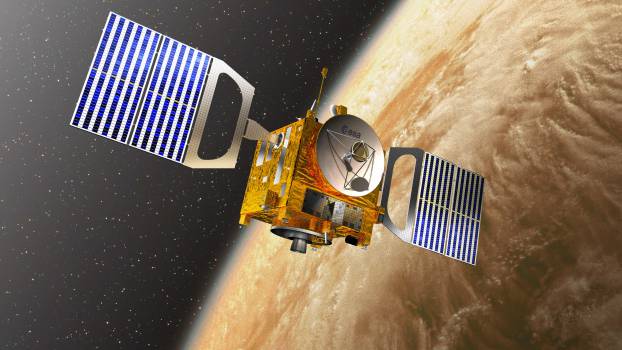The end of the Venus Express mission

December 16th, 2014
Sadly, Venus Express appears to have finally run out of propellant.
Venus Express has been faithfully 'phoning home' every day, but on the 28 Nov the expected signal was not detected. The ground control team swung into action, making repeated efforts to command the satellite using a number of different ground stations, and different parameters. Attempts were made to command "in the blind", that is to say sending commands without receiving any acknowledgment that they'd been received by the spacecraft. After a few days, a limited number of telemetry packets were received from the spacecraft - these were all consistent with the hypothesis that the spacecraft had run out of propellant or oxidiser during a pericentre raising manoeuvre, had repeatedly gone into safe mode, and eventually stabilised into a mode in which the solar panels and High Gain Antenna (HGA) were oriented towards the Sun. While this ensures that the spacecraft still has ample power, the spacecraft is unable to point towards the Earth because its star trackers are not enabled.
Commands to re-enable the spacecraft mode which would allow it to re-orient itself with the HGA pointing to Earth were sent to the spacecraft in December, but this did not work. It was at this point - after over two weeks of attempts to recover the spacecraft, with no hope of recommencing science operations, and with all evidence pointing to an exhaustion of the propellant - that the Mission Manager had no option but to formally declare the end of the Mission.
While we are sad to see the end of the mission, Venus Express has lasted far longer than its originally scheduled mission of 500 days. It has left several Terabytes of science observations, much of which has still to be analysed. While initial work focussed on the 'low-hanging fruit" of first detections and reports, attention has now turned to more detailed study of temporal and spatial variability, intercomparison of datasets, and comparisons with theoretical and computational models.
The EuroVenus consortium's members are studying the datasets from VIRTIS, VMC, SPICAV, and VeRa, therefore representing most of the VEx science payload instruments. EuroVenus also includes Earth-based observations - this complements the space-based observations collaboration, but also extends the observation of Venus into a post-Venus Express future...
An ESA web story about the end of the Venus Express mission can be found here: www.esa.int
Venus Express has been faithfully 'phoning home' every day, but on the 28 Nov the expected signal was not detected. The ground control team swung into action, making repeated efforts to command the satellite using a number of different ground stations, and different parameters. Attempts were made to command "in the blind", that is to say sending commands without receiving any acknowledgment that they'd been received by the spacecraft. After a few days, a limited number of telemetry packets were received from the spacecraft - these were all consistent with the hypothesis that the spacecraft had run out of propellant or oxidiser during a pericentre raising manoeuvre, had repeatedly gone into safe mode, and eventually stabilised into a mode in which the solar panels and High Gain Antenna (HGA) were oriented towards the Sun. While this ensures that the spacecraft still has ample power, the spacecraft is unable to point towards the Earth because its star trackers are not enabled.
Commands to re-enable the spacecraft mode which would allow it to re-orient itself with the HGA pointing to Earth were sent to the spacecraft in December, but this did not work. It was at this point - after over two weeks of attempts to recover the spacecraft, with no hope of recommencing science operations, and with all evidence pointing to an exhaustion of the propellant - that the Mission Manager had no option but to formally declare the end of the Mission.
While we are sad to see the end of the mission, Venus Express has lasted far longer than its originally scheduled mission of 500 days. It has left several Terabytes of science observations, much of which has still to be analysed. While initial work focussed on the 'low-hanging fruit" of first detections and reports, attention has now turned to more detailed study of temporal and spatial variability, intercomparison of datasets, and comparisons with theoretical and computational models.
The EuroVenus consortium's members are studying the datasets from VIRTIS, VMC, SPICAV, and VeRa, therefore representing most of the VEx science payload instruments. EuroVenus also includes Earth-based observations - this complements the space-based observations collaboration, but also extends the observation of Venus into a post-Venus Express future...
An ESA web story about the end of the Venus Express mission can be found here: www.esa.int

